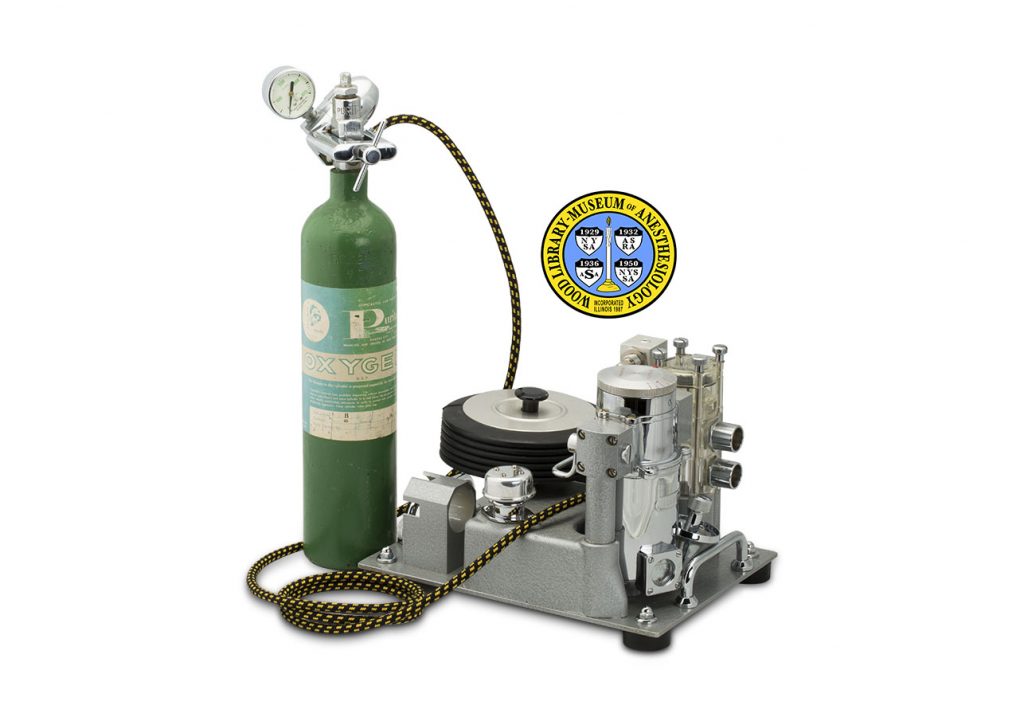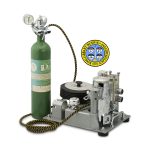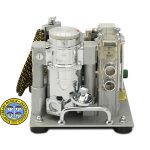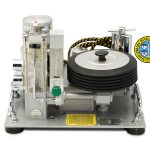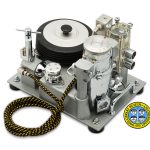Cyprane Fluoxair
Made by Cyprane, Ltd., the Fluoxair apparatus was introduced in 1965 by its British inventor, K. F. Stephens. It was also known as the Haloxair. Both names refer to the liquid agent that it was made to vaporize, halothane (brand name Fluothane), delivered together with air or oxygen. It could also be calibrated to administer chloroform, methoxyflurane, and other volatile agents. Stephens designed the Fluoxair to be portable and flexible enough to serve in difficult conditions, such as those "encountered in developing countries, and by the medical services of the armed forces". Several authors have described its use in these situations.
The Fluoxair could be used alone as an inhalation anesthesia apparatus, or as a ventilator. It could also be used with a carbon dioxide absorber, and in combination with the EMO inhaler and the Oxford Inflating Bellows, both made by Penlon. Capable of providing automatic ventilation, the apparatus could also be used as a demand flow apparatus, relying on the patient's spontaneous respiration. In the 1970s, the demand flow method was criticized as being inferior to the delivery of gases through intermittent positive pressure. Although the Fluoxair was produced into the 1980s, it was not a big seller for Cyprane.
Catalog Record: Cyprane Fluoxair Cyprane Fluoxair
Access Key: aqkn
Accession No.: 2002-12-23-1 B
Title: The Fluoxair / [designed by K. F. Stephens]
Author: Stephens, K. F.
Corporate Author: Cyprane Ltd.
Title variation: Alt Title
Title: Haloxair
Publisher: Keighly, Yorkshire, England : Cyprane Ltd., [between 1964 and ca. 1990].
Subject: Anesthesia, Inhalation – instrumentation.
Subject: Halothane.
Subject: Inhalers, Anesthesia – Great Britain.
Subject: Vaporizers.
Note Type: General
Notes: The first year in the range of possible dates of manufacture is based on the earliest dated descriptions and product literature. The second year in the date range is based on the date that the object was acquired. Edmonson states that Cyprane was acquired by Fraser Sweatman “around 1964”, and that the company continued to manufacture apparatus in Keighly, Yorkshire, into the 1980s.
The front of the apparatus is considered to be that side from which the scale and serial number plates can be read. In this orientation the vaporizer and oxygen supply valve are on the left, the bellows and cylinder yoke on the right.
Married to Puritan oxygen tank from the parts collection for purposes of photography.
Note Type: With
Notes: Two-piece wooden case with four metal clasps, leather handle . Measures approximately 42 x 36 x 27 centimeters.
As received, the following items were stored inside the base: three black corrugated rubber hoses, one made by Sweatman; a black rubber mask made by M.I.E.; a large black rubber head harness; four straight metal connectors; two metal “Y” connectors.
Note Type: Citation
Notes: Cyprane Company File. Archives. Located at: Wood Library-Museum of Anesthesiology, Schaumburg, Illinois.
Note Type: Citation
Notes: Edmondson RS. The History of Cyprane. Journal of Anesthesia History. October, 1995;13(4):6, 8.
Note Type: Citation
Notes: Ezi-Ashi TI, Papworth DP, Nunn JF. Inhalational anaesthesia in developing countries, Part II, review of existing apparatus. Anaesthesia. August, 1983;38(8):736-747.
Note Type: Citation
Notes: Joyce TH, Vacanti CJ, Van Houten RJ, Mitchell GD. A draw-over anesthetic system for peace or war. Anesth Analg. January-February, 1969;48(1):121-128
Note Type: Citation
Notes: MacKay IM. A compact anaesthetic apparatus for emergency use. Canadian Anaesthetists Society Journal. May, 1965;12(3):298-305.
Note Type: Citation
Notes: Macnair DJ. The Haloxair apparatus. BMJ. January, 1969;115(1):29.
Note Type: Citation
Notes: Merrifield, AJ. Hill JDW, Smith K. Performance of the Portablease and the Fluoxair portable anaesthetic equipment, with reference to use under adverse conditions. British Journal of Anaesthesia. January, 1967;39(1):50-70.
Note Type: Citation
Notes: RA Medical website. https://ramedical.com/visit-robert-edmondson-original-founders-cyprane-1947/. Accessed November 9, 2017.
Note Type: Citation
Notes: Romagnoli A, Tousignant M. Versatility of the Haloxair apparatus. Canadian Medical Association Journal. November 7, 1970;103:1055-1056.
Note Type: Citation
Notes: Stephens KF. Transportable apparatus for halothane anaesthesia. BJA. January, 1965;37(1):67-72.
Note Type: Physical Description
Notes: One anesthesia apparatus; The dimensions given in the short description are those with the textile hose at full extension and the bellows at rest; The base alone measures 28 centimeters wide by 21.5 centimeters deep; The length of the hose is approximately 188 centimeters; When fully extended, the height of the bellows is approximately 17 centimeters;
The apparatus is mounted on a metal platform that can either be lifted free of the wooden carrying case or operated while seated in the base of the open case; The platform has one handle near the left edge and one near the right edge; On the left side of the platform, there is an oxygen supply component with a transparent plastic housing; This housing has two metal connectors facing left; To the right of this, and connected to it, is an oxygen control valve; This valve has a knurled green metal knob and a clear flowmeter tube;
Also on the left, immediately behind the oxygen supply component, there is a vaporizer marked “FLUOTHANE”; This legend, a side fill port and a fill gauge all face the back of the unit; The control dial mounted on the top of the vaporizer is marked in the center: “SERIAL No. 1339 [new line] % [new line] FLUOTHANE”; Below this, from left to right, the dial is marked: “5, 4, 3, 2, 1, .5, OFF”; There is a red button immediately below the word “OFF”;
To the right of these components there is a black rubber bellows with a knob that allows its operation by hand; Behind and to the right of the bellows, near the back edge of the platform, a metal fitting is mounted that holds a p[in-indexed oxygen cylinder yoke; This fitting is marked: “TYPE 603-26 [new line] OXYGEN [new line] THERAPY [new line] USE NO OIL [new line] UL [new line] H.P.E. CO.”; A knurled knob below the connector can be tightened to keep the yoke from being dislodged; This yoke is can be removed from this connector, but it is connected to the oxygen valve by a black-and-yellow textile hose; The yoke is equipped with an oxygen pressure gauge marked, from left to right: “0, 1000, 2000, 3000, 4000 [new line] OXYGEN [new line] USE NO OIL [new line] FRASER SWEATMAN, INC. [new line] HATFIELD, PENNA.”;
A yellow plastic label plate is mounted near the front edge of the platform; This plate provides a graph of the percentage of oxygen delivered per minute volume; To the right of this graph, a second, metal label plate is mounted hear the front edge of the platform; This metal plate reads: “THE FLUOXAIR [new line] HALOTHNE-OXYGEN-AIR APPARATUS [new line] MADE IN ENGLAND BY [new line] CYPRANE LIMITED [new line] KEIGHLY, YORKSHIRE [new line] SERIAL No. 937 [new line] PATENT APPLIED FOR”; To the right of this, a metal plate reads: “THE FLUOXAIR [new line] HALOTHANE, OXYGEN, AIR APPARATUS [new line] MADE IN ENGLAND BY [new line] CYPRANE LIMITED [new line] KEIGHLY, YORKSHIRE [new line] SERIAL NO. 937 [new line] PATENT APPLIED FOR”.
Note Type: Reproduction
Notes: Photographed by Mr. Steve Donisch, June 20, 2017.
Note Type: Acquisition
Notes: Gift of J. Roger Maltby, M.D.
Note Type: Historical
Notes: A brief history of Cyprane, Limited was published in 1995 by Robert S. Edmondson, M.D. He was the son of the founder, Mr. “Bill” Edmondson, a former employee of Coxeter and its successor, British Oxygen Co. Mr. Edmondson created his new company in 1947. Cyprane was sold to its North American distributor, Fraser Sweatman, Inc., around 1964. Fraser Sweatman, in turn, was acquired by British Oxygen. Cyprane continued to manufacture equipment in Keighly, Yorkshire, into the 1980s.
This apparatus was introduced as the “Haloxair” in 1965 by its British inventor, K. F. Stephens, M.D. It was marketed by Cyprane as the “Fluoxair”, and was known to anesthesiologists by both names. The two names refer to the liquid anesthetic that it was made to vaporize, halothane (brand name Fluothane). The operating instructions state that it could also be adjusted to administer chloroform, as well as a mixture of halothane and ether. Additional concentration dials could be purchased, which were calibrated for methoxyflurane, trichloroethylene and other agents. Dr. Stephens designed it to be portable and flexible enough to serve in difficult conditions, such as those “encountered in developing countries, and by the medical services of the armed forces.” Several authors have described its use in these situations.
The apparatus could be removed from the case, or used while seated in the lower portion of the case. It could be used alone either as an inhalation anesthesia apparatus, or as a ventilator. It could also be used in combination with the EMO inhaler and/or the Oxford Inflating Bellows, both made by Penlon. Capable of providing automatic ventilation, it could also be used as a demand flow apparatus, relying on the patient’s spontaneous respiration for the delivery of gases. In the 1970s, the demand flow method was criticized as being inferior to the delivery of gases through intermittent positive pressure. R. S. Edmondson, M.D., referred to this in his 1995 history of the company, stating that “the Haloxair …. never achieved great sales”.
Note Type: Exhibition
Notes: Selected for the WLM website.
